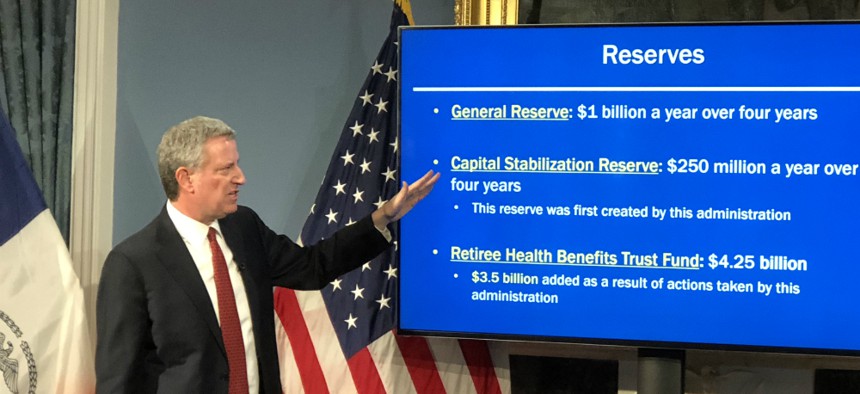Bill de Blasio
With wary eye on Washington, NYC budget continues to grow
Mayor Bill de Blasio laid out his proposed budget on Thursday and he did not suggest cuts to compensate for new policies from President Donald Trump or Gov. Andrew Cuomo.

New York City Mayor Bill de Blasio goes over his budget's key points. Jeff Coltin
New York City Mayor Bill de Blasio unveiled an $88.7 billion budget with no scene-stealing initiatives and seemingly little regard for the uncertain future imposed by President Donald Trump and his Republican allies in Congress.
Instead, de Blasio emphasized his ongoing commitment to equality. Even in the face of potential funding cuts from Washington, de Blasio said, “We would make decisions based on a very simple notion … what will help make us the fairest big city in America?”
Creating the fairest big city takes a lot of money, and New York City’s budget continues to grow. This preliminary fiscal year 2019 budget increases total spending by more than $3 billion over last year’s adopted budget. And it’s almost $14 billion more than de Blasio’s first budget, adopted in 2014.
While de Blasio said that he eschewed major new spending initiatives in light of conditions in Washington, D.C., he did not address head-on possible budget shortfalls caused by the new federal tax law, which will disadvantage New York, Trump’s proposed cuts to domestic spending, or Gov. Andrew Cuomo’s demands that New York City spend more on the MTA.
New York City Council Finance Chairman Daniel Dromm will lead the budget hearings over the next few months, as the city proceeds towards the July 1 budget deadline. Dromm told City & State that the budget didn’t include any surprises, but he expressed some hesitation about its growth. “We just don’t know what’s happening in Washington,” he said.
The Citizens Budget Commission, a nonprofit budget watchdog, echoed Dromm’s comments. Executive Director Carol Kellerman issued a statement saying the budget “neither addresses issues spawned by the recently enacted federal tax law and possible budget cuts nor pending State actions that could reduce resources available for city services. Most importantly, no additions will be made to the City's reserves.”
De Blasio brushed off questions about whether the city should save more, saying that the reserve funds are at their highest level ever, and are the city’s “first line of defense” in case of an economic downturn.
Despite the increase in spending, de Blasio expects a balanced budget, thanks to the city’s strong economy, growing population and falling unemployment. But city agencies were still asked to find places to cut back in their budgets. That led to $900 million in savings, with $500 million more expected by the time de Blasio releases his executive budget in April. The city also saved some $300 million from a partial hiring freeze, and found “hundreds of millions” in corporate taxes thanks to audits from the city’s Department of Finance.
That saving was offset by new spending, like $12 million to get body cameras on every NYPD patrol officer by the end of 2018, and $200 million to upgrade heating systems at NYCHA developments.
The mayor’s preliminary budget did not include the $450 million in additional MTA funding that the state asked the city to cover.
De Blasio blamed Albany for other things, saying the city might have to spend up to $750 million more due to budget cuts and shifts from the state government. The mayor said Gov. Andrew Cuomo’s executive budget gave the city $200 million less in school aid than expected. De Blasio also highlighted cuts to child welfare services and juvenile justice programs.
But the budget is surprisingly malleable for a document with numbers in black and white, and the state calculates the numbers differently: An aide to Cuomo told NY1 that the state budget actually sends $500 million more to the city than last year.
NEXT STORY: Who’s who at the MTA

